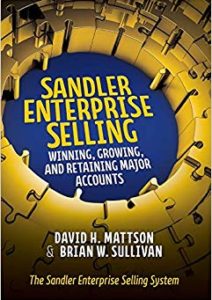Many of us remember a TV game show from the 60’s, 70’s and 80’s called Hollywood Squares. Contestants competed for cash and prizes in a live, oversized version of tic-tac-toe. A vertical stack of nine cubes formed the game’s structure, with each cube containing a celebrity seated at a desk facing the contestants. The stars were asked questions by the host and the contestants had to determine the truth of the answers to gain squares in the correct pattern to win the game. Paul Lynde, Sandy Duncan, Joan Rivers, and Charley Weaver were typical of the celebrities, and determining the truth in their misleading answers was quite a challenge for the contestants.
Hold that thought and think of team selling. In pursuing major accounts, it’s a mandatory strategy. But what about the other side’s collaborative strategy – team buying?
In large accounts, buyer networks assemble individuals from across the organization, bringing different perspectives – legal, procurement, finance, etc. And while we know how important it is to understand these buyers, we typically focus on their functions. But there’s much more than functions that impact effective communications with buyers.
Back to Hollywood Squares. Speed forward in time from the 80’s to today and envision 2020’s tic-tac-toe grid. We all know it well – those Zoom call frames filled with a prospect account’s buyers. No, Paul Lynde and his fellow celebrities won’t appear on your screen, but a modern-day cast of buyers will. And often, these buyers are no more truthful, trying to mislead us in much the same way those celebrities did. Just as it was critical for the Hollywood Squares contestants to ascertain Sandy Duncan’s behaviors to win, we must do the same with today’s Zoom buyers. For the same reason – to win.
For example, the accounting manager on the screen represents a familiar function. So, it’s natural to make assumptions about accounting’s perspective. But what about the accounting manager as a person – his or her behavioral style, traits and tendencies? Do we assume all accounting managers are the same? Remembering that “people buy from people”, how can you increase your chances of successful communication with buyers as the real people they are?
You start by identifying their behavioral profiles. DISC, the proven behavior assessment process, helps accomplish this. Consider the behaviors of the many buyer personalities on your Zoom screen. From a DISC perspective, is the attorney a “D” – dominant? Is the finance manager a “C” – compliant? What about the marketing manager, an “I” – influencer, and the project manager, an “S” – supportive? To add complexity, how do their styles align to the personalities on your selling team? Without a framework, you’re flying blind. With a practical guide, though, you have the roadmap for identifying and adapting to the behavioral puzzle.
In major account deals, the stakes are high. With our sales bias, we typically think about the costs incurred by selling organizations in efforts to win. Money, people, time, and more. But what about the spends of the buying organizations? The same types of costs apply but with multipliers. Why? Because the buying organizations are in pain, compelling the need for the purchase. Something must be improved. And if a bad purchase decision is made, the pain will increase greatly. Heads will often roll. Lots of stress, lots of risks. The drama on both sides ratchets up the emotions. And emotions are the mortal enemies of communication. Selling teams must be ready, prepared with a behavioral strategy.
Start with a Go/No-Go process to ensure you’re pursuing the right deals – the true profile deals. The only thing worse than pursuing a bad deal is winning it. And following the behavioral framework can be the key competitive advantage to help ensure that doesn’t happen.
The Sandler Enterprise Selling Team Buying Tool provides a four-step guide to navigate behavioral buyer networks. First, key buying team members are identified by title and by their impact on the specific deal – high, medium, or low. Their DISC styles are then identified through communication among the selling team members, collaborating on experiences with the individual buyers. That’s team selling. Then, the customized motivators and demotivators for each buyer are identified, providing the path.
Next, the selling team members are profiled – each teammate’s DISC style and traits. With the behavioral work done to this point on both sides, you’re ready to craft the selling strategies for effectively communicating with each buyer – what to do and often more importantly, what not to do. Joan Rivers, of course, is very different than Sandy Duncan and must be treated accordingly.
The final step involves identifying specific action items to take, including due dates and the selling team members responsible. Carefully planning these actions by aligning complementary behavioral styles sets the stage for productive communication – ducks with ducks!
The behavioral complexities of major account buyer networks are major challenges but can be overcome. By accounting for the different styles of both the buyers and the sellers, you can make informed decisions to adapt your behaviors to maximize successful communication. Yes, even in our virtual world of disconnected connectivity. Put in the time and effort and you’ll inject clarity into the haze of misinformation. And, regardless of Charley Weaver’s best efforts, you’ll win the square!















































Comments (1)
This is what all Sales people, business Owners need to make their team sharpen their skills and forecast sales